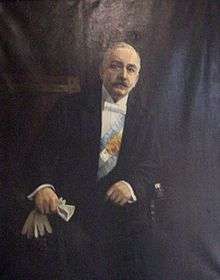Roque Sáenz Peña
| Roque Sáenz Peña | |
|---|---|
 | |
| 17th President of Argentina | |
|
In office October 12, 1910 – August 9, 1914 | |
| Vice President | Victorino de la Plaza |
| Preceded by | José Figueroa Alcorta |
| Succeeded by | Victorino de la Plaza |
| Personal details | |
| Born |
March 19, 1851 Buenos Aires |
| Died |
August 9, 1914 (aged 63) Buenos Aires |
| Nationality | Argentina |
| Political party | National Autonomist Party |
| Spouse(s) | Rosa Isidora González Delgado |
| Profession | Lawyer |
Roque Sáenz Peña Lahitte (March 19, 1851 – August 9, 1914) was President of Argentina from 12 October 1910 to 9 August 1914, when he died in office. He was the son of former President Luis Sáenz Peña.
He was responsible for passing Law 8871, known as "Sáenz Peña Law", which greatly reformed the Argentine electoral system, making the vote secret, universal and compulsory for males over 18. This effectively ended the rule by electoral fraud of the conservative Argentine oligarchy, and paved the way for the rise of the Radical Civic Union in the first free elections of the country. President Roque Sáenz Peña Avenue in Buenos Aires is named after him.
He also served in the War of the Pacific as a lieutenant colonel of the Peruvian Army, and was made prisoner by Chile for six months following the Battle of Arica. He later served as Ambassador to Spain (1906–1907) and Italy (1907–1910)
His daughter married Carlos Saavedra Lamas, academic and politician, and the first Latin American Nobel Peace Prize recipient.
References
| Wikilivres has original media or text related to this article: |
- index.html La presidencia de Roque Sáenz Peña 1910-1914.
- Accidente de Roque Sáenz Peña en 1905 (Lima).
- Rulers.org
External links
| Political offices | ||
|---|---|---|
| Preceded by José Figueroa |
President of Argentina 1910–1914 |
Succeeded by Victorino de la Plaza |